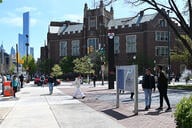You have /5 articles left.
Sign up for a free account or log in.
Economists are often criticized for treating colleges as if they were factories: using models that evaluate college efficiency in creating outputs (student completions) for a given input (cost).
In fact, in many ways a college education is like the factory production process: students start at the beginning and then, after a sequence of “inputs” in the form of courses and support services, some graduate successfully at the end.
Unfortunately, economic analyses of college efficiency typically do not look at college as a process. Economic models have traditionally tried to understand college efficiency through a simple input-per-output equation. For example, they may look at a graduation rate in 2012 and compare that to the resources available in the college in 2012.
This approach might be reasonable if college only took one year to complete. It might be reasonable if the college experience was a steady dosage, with the freshman year being the same as the sophomore year. It might be reasonable if there were as many freshmen as sophomores. Needless to say, college is not one year. First-year and second-year requirements are not the same and have different costs. And at community colleges the freshman class is typically more than twice the size of the sophomore class.
The truth is, contemporary factory managers have a much better understanding of their factory's production process than economists do of how colleges operate. Factory managers understand that it matters what happens along the entire chain of production. They know that getting more output at the front end means that the whole production chain must work better. Improvements in one area won't help if they create bottlenecks later on. They also know that efficiency does not come from sacrificing quality.
The same understanding should be applied to the college experience. Improving the quality of instruction in introductory courses won't help if students can't access high-demand majors, such as nursing. Pouring resources into one early intervention won’t help if other programs lose resources and decline in quality as a result. And increasing retention rates won't improve efficiency if it leads students to drop out in their second year instead of their first. In fact, improved retention requires more upper-level courses (which tend to cost more) and makes colleges look less efficient if graduation rates remain unchanged.
In sum, looking at snapshots is not likely to help make colleges more efficient. Instead, it would be more helpful to investigate the process of college and understand what resources are available to a cohort of students as they progress through their college years. We have begun this investigation by using detailed transcript and costs data from one college and simulating different student progression rates.
As well as providing a better understanding of what resources are needed to get a student through to completion, this model enables us to evaluate different reform strategies. We find that increasing first-year math pass rates will increase completions and make the college more efficient. But an equivalent improvement in preparing students to be college-ready has a much greater effect on efficiency.
By contrast, improving persistence rates helps improve completion rates but it does not make the college that much more efficient: many students simply drop out having taken more classes. Finally, getting “lingerers” -- students who have persisted for years and accrued large numbers of credits -- to complete their awards will significantly boost efficiency, as will ensuring that more students who transfer to a four-year institutions earn an associate degree before they transfer.
Much more work needs to be done in this area. But to better understand the economics of college completion we need to more accurately model the resources that are required as students progress through college.




